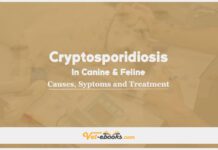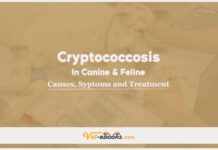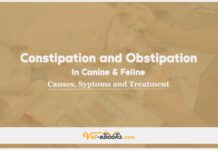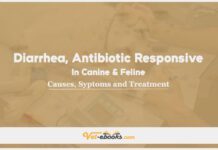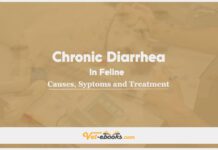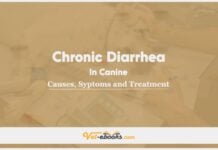Canine Coronavirus infections: Causes, Symptoms and Treatment

Overview
A viral infection that leads to sporadic outbreaks of vomiting and diarrhea (CECoV) or respiratory illness (CRCoV) in dogs.
Causes
- Canine enteric coronavirus (CCoV) causes sporadic outbreaks of enteritis in dogs and is found worldwide.
- Canine pantropic coronavirus (CPCoV) is a variant of CCoV and results in a fatal disease in dogs under six months old, primarily reported in Europe.
- Both CCoV and CPCoV are closely related to feline infectious peritonitis (FIP) virus and feline enteric coronavirus.
- Canine respiratory coronavirus (CRCoV) is linked to canine infectious respiratory disease complex (kennel cough), is found worldwide, and is genetically and serologically distinct from CCoV.
- The incubation period for these viruses ranges from 1 to 3 days.
- CCoV infection typically goes unnoticed but can lead to mild to severe enteritis. It has been associated with deaths in young puppies and primarily infects the upper two-thirds of the small intestine and related lymph nodes, with crypt cells being unaffected.
- Simultaneous infection with canine parvovirus (CPV)-2 is possible and often severe, frequently resulting in fatality.
- CPCoV infects the intestinal tract and, after a brief viremic phase, spreads to organs like the spleen, lungs, and brain.
- Coronaviruses undergo rapid evolution, leading to high variability. Differences in virulence are likely among different isolates.
Risk factors
- The most significant risk factor for these viruses is stress.
- Sporadic outbreaks have been observed in dogs participating in dog shows and in kennels where new dogs are frequently introduced.
- Overcrowding and unclean conditions can also contribute to the spread of illness.
- For CCoV and CPCoV, the primary source of infection is feces, and the virus can be shed for up to two weeks.
- In the case of CRCoV, respiratory secretions and contaminated objects (fomites) are likely sources of infection.
- Coronaviruses exhibit rapid evolutionary changes, displaying high variability, and it’s likely that individual isolates differ in their virulence.
- These viruses are distributed worldwide, including among wild canids.
- For CECoV, feces serve as the primary source of infection, and the infection is typically asymptomatic.
- The virus is mainly confined to the upper two-thirds of the small intestine and related lymph nodes.
- Unlike canine parvovirus (CPV), crypt cells are spared from infection.
- Dogs may experience mild to severe enteritis, with most recovering without complications.
- Fatal cases have been reported in young puppies.
- The virus is shed in feces for approximately two weeks.
- Concurrent infection with CPV leads to severe diarrhea and is often fatal.
- CRCoV is primarily transmitted through respiratory secretions and contaminated objects (fomites) and is associated with the kennel cough complex.
- Some dogs can carry the virus without showing symptoms.
History
- The susceptibility to this disease is observed in wild and domestic dogs exclusively.
- Cats can carry the virus without showing symptoms.
- There is no particular age or breed preference for infection.
- The most significant risk factor is stress, which can result from factors such as intensive training and overcrowding.
- Sporadic outbreaks have been observed in dogs participating in shows and in kennels where new dogs are frequently introduced.
- Clinical illness is more likely to occur in crowded and unsanitary conditions.
- In the case of CRCoV, infections may exhibit seasonality, with a higher incidence in the winter months.
Physical examination
- The severity of the illness can vary significantly. Virulent strains of CPCoV can lead to systemic disease.
- In most cases, adults infected with these viruses do not display any apparent symptoms.
- Puppies, on the other hand, can experience mild to severe enteritis, which can occasionally be fatal.
- The diarrhea associated with these infections can be explosive, with a characteristic yellow-green or orange color. It is typically loose or liquid, often having a distinct and unpleasant odor. It may persist for several days to over three weeks and may recur. Young dogs may suffer from severe and prolonged diarrhea, leading to dehydration.
- Vomiting is another common symptom.
- In the case of CRCoV, coughing and difficulty in breathing are associated with the kennel cough complex.
- Other symptoms may include loss of appetite and lethargy.
- For CPCoV infections, additional signs can include fever, loss of appetite, depression, vomiting, hemorrhagic enteritis, respiratory distress, and persistent leukopenia (low white blood cell count) that lasts for more than one week. Ataxia (loss of coordination), seizures, and death are also possible.
1- From History and Physical Examination
2- Diagnostic Procedures
- Viral isolation for CCoV and CRCoV is possible but not recommended as a primary diagnostic method.
- A more specific approach involves using reverse transcriptase polymerase chain reaction (RT-PCR) techniques. For CCoV, feces can be used, while respiratory swabs are suitable for CRCoV. The presence of CPCoV is determined by the detection of the virus in extraintestinal organs.
- In fatal cases, immunofluorescence of the small intestine may reveal the presence of viral antigens in cells lining the villous epithelium.
Pathological findings
- Gross observations often show a dilated small intestine filled with gas and watery green-yellow material.
- Bowel loops may exhibit congestion and hemorrhaging, and the mesenteric lymph nodes can appear enlarged and edematous.
- Histopathological analysis typically reveals atrophy and fusion of intestinal villi, deepening of crypts, increased cellularity in the lamina propria, flattening of epithelial cells, and an increase in goblet cells.
- In cases of CPCoV, hemorrhagic lesions may be present in various organs such as the lungs, small intestines, spleen, and lymph nodes.
CBC (Complete Blood Count), biochemistry, and urinalysis tests
Tests are typically within the normal range. However, lymphopenia may be observed in cases involving more aggressive CCoV variants.
Other laboratory tests
Serologic tests are available for diagnosis. These tests are not standardized and can be challenging to interpret because asymptomatic infections are quite common.
3- Differential Diagnosis
- Consider all potential factors contributing to diarrhea, including underlying systemic or metabolic conditions, as well as specific intestinal issues.
- In very young puppies, acute enterocolitis can also result from dietary indiscretion or intolerance, exposure to certain drugs (such as antibiotics), ingestion of toxins (like lead), parasitic infections (like cryptosporidiosis, giardiasis, hookworms, or roundworms), the presence of infectious agents (such as parvovirus, salmonellosis, bacterial overgrowth in the GI tract, campylobacteriosis, or clostridial enterotoxicosis), systemic organ dysfunction affecting organs like the kidneys, liver, pancreas, or heart, metabolic disorders (such as hypoadrenocorticism or hypoglycemia), and the ingestion of foreign bodies in the GI tract.
- Similarly, when considering acute respiratory disease in young animals, various infectious causes should be taken into account, including viral infections like adenovirus-2, parainfluenza, herpes, canine influenza, and distemper, bacterial infections such as Bordetella bronchiseptica and Streptococcus equi zooepidemicus, Mycoplasma cynos, fungal diseases like blastomycosis and histoplasmosis, and certain parasitic infections including Crenosoma vulpis, Oslerus osleri, Filaroides, migratory parasites, and heartworm, as well as conditions like aspiration pneumonia.
General
- The majority of affected dogs naturally recuperate without the need for medical intervention.
- In cases of CECoV, hospitalization for the administration of supportive therapies, including fluids and electrolytes, is recommended for severe infections with dehydration, particularly in very young puppies.
- For CRCoV, treatment is provided for dogs with kennel cough complex.
Medications:
- Antibiotics should be considered for administration in cases where enteritis is severe, or if there are indications of sepsis or respiratory illness.
- Select antibiotics that are effective for gastrointestinal tract infections, such as ampicillin, ceftiofur, cefazolin, and gentamicin.
- Ampicillin 10-20 mg\kg for 5 days.
- Ceftiofur 2-5 mg\kg for 5 days.
- Cefazolin 22 mg\kg for 5 days.
- Gentamicin 2-4 mg\kg for 5 days.
Some Notes:
- Both inactivated and live viral vaccines are available, and while they seem safe, their effectiveness remains uncertain, except for a limited period of 2–4 weeks after vaccination.
- Generally, vaccination is not recommended.
- It’s important to note that vaccines for CECoV do not provide cross-protection against CRCoV.
- Diarrhea associated with these infections can endure for 10–12 days and may recur.
- The prognosis is typically favorable, except in cases of severe infections in young puppies.
- Most dogs recover after a few days of illness.
- It’s possible for fluid or soft stools to persist for several weeks.
- The virus is easily inactivated by disinfectants, drying, or steam cleaning.
Tip
Do You Want To Increase Your Veterinary Knowledge and Practical Skills?
You Can Now Browse and Download +3000 Books For Veterinary Professionals & Students Online.
Download Veterinary Books

